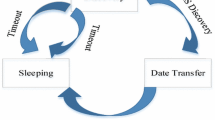Abstract
Due to the huge potential profit that sensor networks may provide in industrial and socio-economic areas, they attract the attention of many researchers around the world. However, their development level has not reached an acceptable status due to several barriers. Each sensor is equipped with a battery but of limited energy which causes major obstacle on the lifetime of the network. These sensors have communicated with the sink which might be far away. A mobile sink can be considered as an alternative solution to the problems already identified, but it also raises new challenges such as the location of the mobile sink and communication with the sensors. In this paper, we proposed a new robust routing protocol called Tree and Mobile Sink-based Routing Protocol. This protocol is based on the intra-cluster multi-hop concept using a constructed tree for data routing and a new strategy for sink mobility to collect data from cluster heads. In order to evaluate the performance of algorithm, we implemented it using the NS2 network simulator.













Similar content being viewed by others
References
Ahn, S., & Kim, D. (2006). Proactive context-aware sensor networks. In K. Römer, H. Karl, & F. Mattern (Eds.), Wireless sensor networks, LNCS 3868 (p. 3853). Berlin: Springer.
Banerjee, T., Xie, B., Jun, J. H., & Agrawal, D. P. (2010). Increasing lifetime of wire less sensor networks using controllable mobile cluster heads. Wireless Communications and Mobile Computing, 10, 313–336.
Chen, T. S., Tsai, H., Chang, Y., & Chen, T. C. (2013). Geographic convergecast using mobile sink in wireless sensor networks. Computer Communications, 36(4), 445–458.
Dehni, L., Beennabi, Y., & Krief, F. (2003) LEA2C : Une nouvelle approche de routage dans les réseaux de capteurs pour l’optimisation de la consommation d’énergie, Univ. Paris 13.
Ducrocq, T., Mitton, N., & Hauspie, M. (2012). Clustering pour l’optimisation de la durée de vie des réseaux de capteurs sans fil. In 14iemes Rencontres Francophones sur les Aspects Algorithmiques des télécommunications (AlgoTel), La Grande Motte, France.
Ghafoor, S., Rehmani, M. H., Cho, S., & Park, S. H. (2014). An efficient trajectory design for mobile sink in a wireless sensor networks. Computers & Electrical Engineering, 40(7), 2089–2100.
Heinzelman, W., Chandrakasan, A., & Balakrishnan, H. (2002). Energy efficient communication protocol for wireless microsensor networks. Sensor, 2, 258–269.
He, L., Pan, J., & Xu, J. (2013). Progressive approach to reducing data collection latency in wireless sensor networks with mobile elements. IEEE Transactions on Mobile Computing (TMC), 12(7), 1308–1320.
Jafri, M., Javaid, N., & Khan, Z. (2013). Maximizing the lifetime of multi-chain PEGASIS using sink mobility. World Applied Sciences Journal, 21(9), 1283–1289.
Kinalis, A., Nikoletseas, S., Patroumpa, D., & Rolim, J. (2012). Biased sink mobility with adaptative stop times for low latency data collection in sensor networks. Information Fusion, 15, 56–63.
Krimer, P., & Musilek, P. (2015). Bio-inspired routing strategies for wireless sensor networks (Vol. 85, pp. 155–181). Basel: Springer International Publishing.
Liu, X., Zhao, H., Yang, X., & Li, X. (2013). SinkTrail: A proactive data reporting protocol for wireless sensor networks. IEEE Transactions on Computers (TC), 62(1), 151–162.
Mottaghi, S., & Zahabi, M. R. (2015). Optimizing LEACH clustering algorithm with mobile sink and rendezvous nodes. International Journal of Electronics and Communications (AEU), 69(2), 507–514.
Mottaghi, S., & Zahabi, M. (2015). Optimizing LEACH clustering algorithm with mobile sink and rendezvous nodes. AEU-International Journal of Electronics and Communications, 69(2), 507–514.
Nazir, B., & Hasbullah, H. (2010) Mobile sink based routing protocol (MSRP) for prolonging network lifetime in clustered wireless sensor network. In Proceedings of the IEEE international conference on computer applications and industrial electronics (ICCAIE), Kuala Lumpur, Malaysia, pp. 624–629
Saad, E., Awadalla, M., & Darwish, R. (2008). A data gathering algorithm for a mobile sink in large-scale sensor networks. In Wireless and mobile communications, on the fourth international conference, pp. 207–213.
Sen, F., Bing, Q., & Liangrui, T. (2011). An improved energy-efficient pegasis based protocol in wireless sensor networks. Fuzzy Systems and Knowledge Discovery (FSKD), 4, 2230–2233.
Senouci, M. R., Mellouk, A., Senouci, H., & Aissani, A. (2012). Performance evaluation of network lifetime spatial-temporal distribution for WSN routing protocols. Journal of Network and Computer Applications, 35, 1317–1328.
Shi, L., Zhang, B., Mouftah, H. T., & Ma, J. (2013). DDRP: An efficient data-driven routing protocol for wireless sensor networks with mobile sinks. International Journal of Communication Systems, 26, 1341–1355.
Shi, L., Zhang, B., Mouftah, H., & Ma, J. (2013). DDRP : An efficient data-driven routing protocol for wireless sensor networks with mobile sinks. International Journal of Communication Systems, 26(10), 1341–1355.
Vecchio, M., Viana, A., Ziviani, A., & Friedman, R. (2010). Deep: Density-based proactive data dissemination protocol for wireless sensor networks with uncontrolled sink mobility. Computer Communications, 33(8), 929–939.
Yu, F., Park, S., Lee, E., & Kim, S. H. (2010). Elastic routing: A novel geographic routing for mobile sinks in wireless sensor networks. IET Communications, 4, 716–727.
Zhao, M., & Yang, Y. (2012). Bounded relay hop mobile data gathering in wireless sensor networks. IEEE Transactions on Computers (TC), 61(2), 265–277.
Author information
Authors and Affiliations
Corresponding author
Rights and permissions
About this article
Cite this article
Mechta, D., Harous, S. & Alem, I. Improving Wireless Sensor Networks Durability Through Efficient Sink Motion Strategy: TMSRP. Wireless Pers Commun 99, 1661–1682 (2018). https://doi.org/10.1007/s11277-018-5329-x
Published:
Issue Date:
DOI: https://doi.org/10.1007/s11277-018-5329-x




